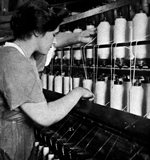
Grades 9-12

Don't have an account yet? Sign up for free
Don't have an account yet? Sign up for free


In reading/watching and discussing Lyddie, the students travel in time to an 1840s textile mill in Lowell, Massachusetts. Lyddie Worthen, the main character, is employed in the mill. She tries in vain to earn and save enough money to reunite her family.
The story begins when a huge bear enters Lyddie’s family’s cabin. This frightening event precipitates the breakup of Lyddie’s family. Her unstable mother and her father leave home, and she and her brother are hired out to help pay off the family’s debts. In response to these events, Lyddie dreams of reuniting her family. To pursue her dream, she takes a job in the cotton mills of Lowell, Massachusettes.
As the students discuss this story, they will learn how Lyddie’s life is affected by circumstances we can describe by modern economic concepts such as scarcity, opportunity cost, incentives, saving, and interest. By visiting Internet sites, they will also learn about child labor practices, the growth of government regulation and labor unions, and other aspects of the world in which Lyddie lived, worked, and dreamed. Finally, they will use mathematical skills to complete an activity in which they calculate income and expenses in a simulated effort to help someone reach financial goals.
After reading/watching the novel, the students will explore economic concepts by discussing answers to questions the lesson poses. The final activity involves a worksheet that calls upon students to assist a character who needs to evaluate his income against his expenditures to determine how he might meet his financial goals.

 atever we gave up to achieve our first choice must also be counted as part of the value of our first choice. Opportunity cost is the value of our second-best choice. (For example, in the teacher’s decision regarding the vacation or the new car, if the vacation was selected, then the opportunity cost would have been the new car.) Ask the students to identify the opportunity cost of the decisions they mentioned above.
atever we gave up to achieve our first choice must also be counted as part of the value of our first choice. Opportunity cost is the value of our second-best choice. (For example, in the teacher’s decision regarding the vacation or the new car, if the vacation was selected, then the opportunity cost would have been the new car.) Ask the students to identify the opportunity cost of the decisions they mentioned above. not exist in the workplaces in the United States today?
not exist in the workplaces in the United States today?Use the attached files Making Sound Financial Decisions worksheet for the conclusion activity. The Teacher’s version provides the answers to the questions.
Note: Written responses given by the students to help Marty achieve his financial goal of purchasing a new iPod will vary. Answers that either increase Marty’s income or reduce his expenditures so that he can achieve his goal will be correct.
The topic of child labor practices offers many opportunities for studies across the curriculum. Most of the Web sites in the Resource section have lessons and activities that can easily be used to extend this lesson. Here are some suggestions for using these sites:
Although there are several online tests and quizzes for Lyddie this activity provides a short evaluative means to assess how well students have learned the economic content found in this lesson.

Grades 9-12

Grades 6-8, 9-12

Content Partner
Grades 3-5, 6-8

Grades K-2
